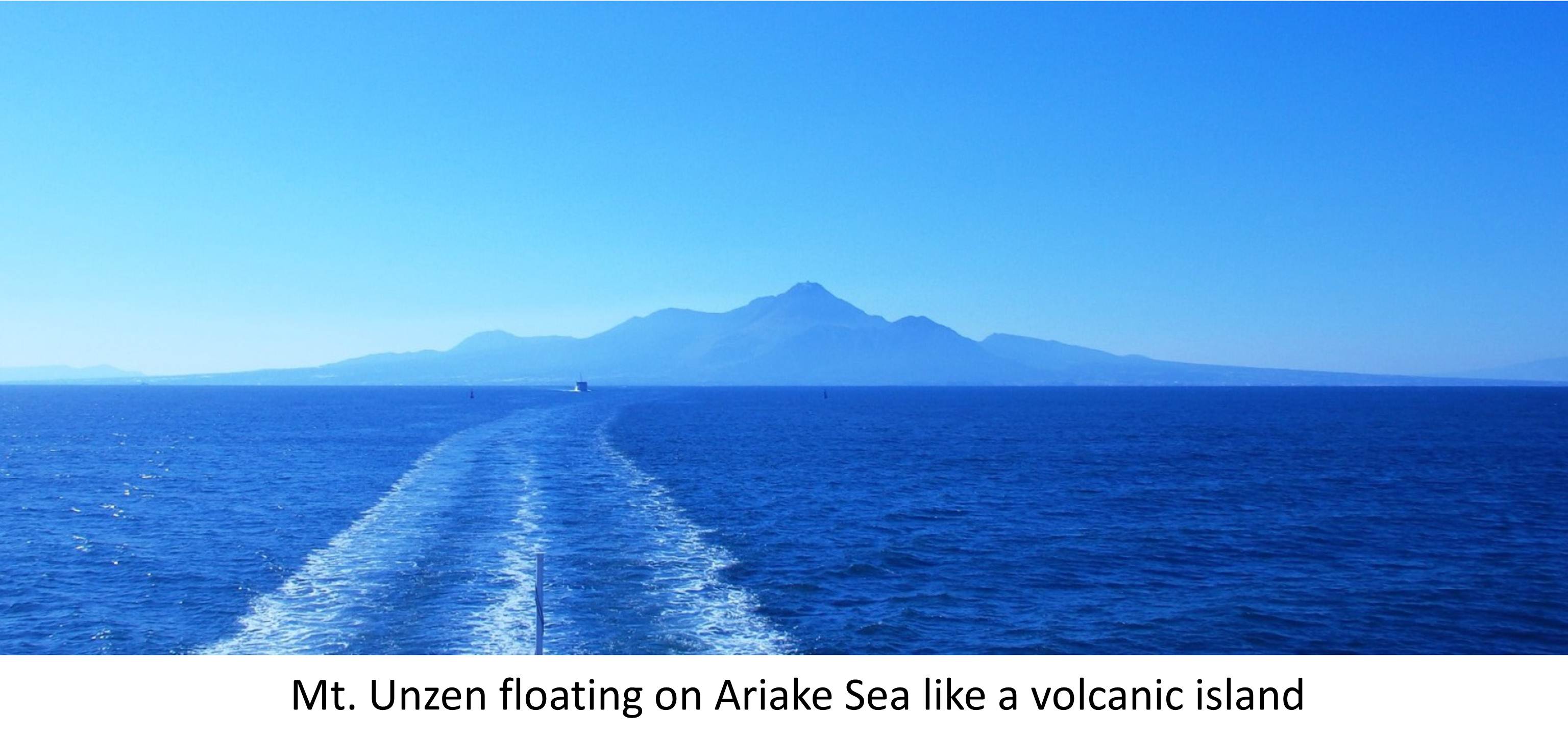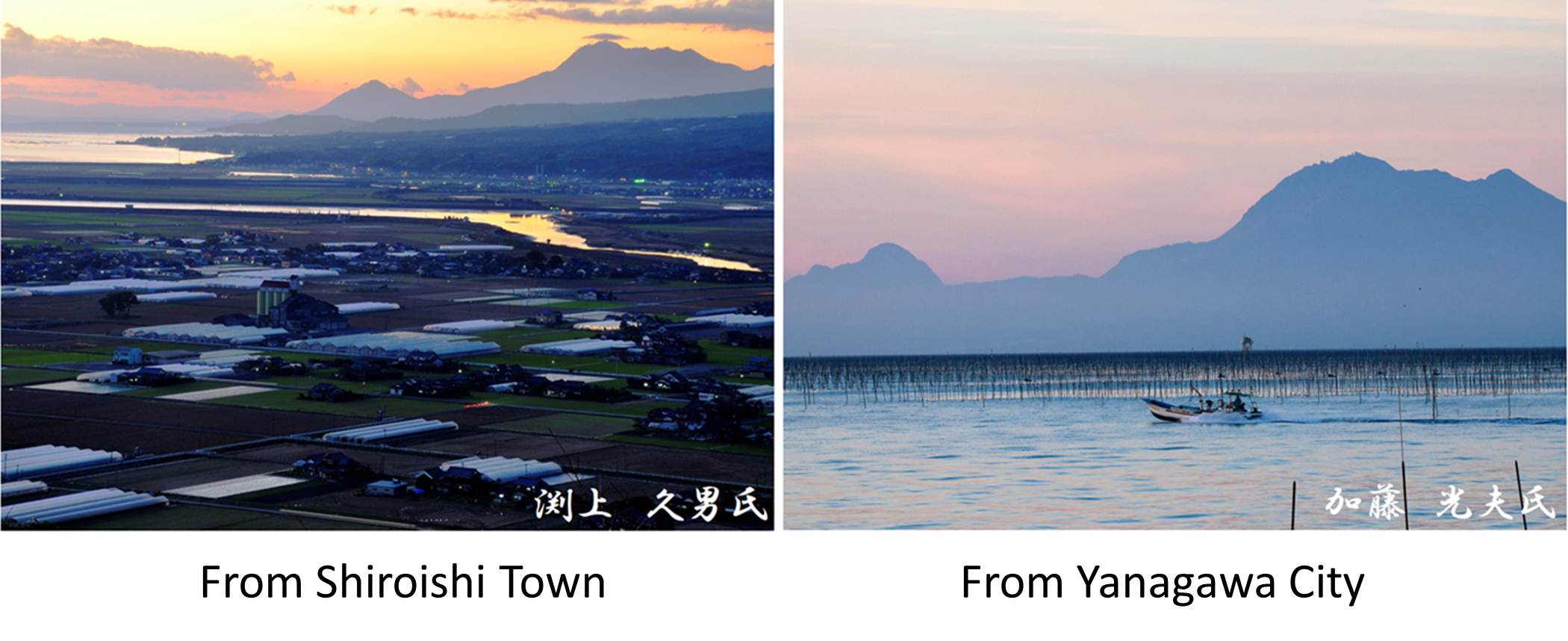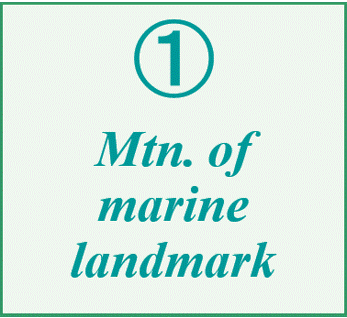日本語

There exist "7 secrets" on Mt.Unzen generally unknown. Whereas the height of Mt.Unzen is 67th in Kyushu, it has played unexpectedly important roles in Kyushu Island, and has built up an original history. We will introduce such "7 secrets" below.
①Mountain of marine landmark in Kyushu Island


Mt.Unzen is highly visible from a long distance, because it floats on the mid of Ariake Sea like a volcanic island without obstacles around. Although Mt.Unzen is visible from Yoshinogari Ruins (Saga Prefecture) as an example, the centerline of ruins is found to be pointing to the mountain actually. It indicates that the ancient Yoshinogari residents determined the configuration of the buildings viewing Mt.Unzen 2000 years ago. Another example is Kengun Shrine (Kumamoto Prefecture), the oldest shrine in Kumamoto City. The 1.2km approach way of the shrine is pointing to Mt.Unzen in a straight line. These facts mean that Mt.Unzen has been viewed as an important landmark of Ariake Sea Region since the ancient times (Ref. 6).
Furthermore, the mountain is visible from Oita Prefecture (Kuju Mountain Range, Mt.Sobo, etc.), Kagoshima Prefecture (Kirishima Mountain Range, Nagashima Islands, etc.), thus visible from all prefectures of Kyushu Island. On the background of such property resembling Mt.Fuji, Mt.Unzen is designated "(national) special places of scenic beauty", just with Mt. Fuji for the mountain places (Ref. 7).
As described above, Mt.Unzen is the very visible "marine landmark" in Kyushu Island.
②Mountain with the guardian deity of Kyushu Island enshrined

Mt.Unzen is one of the earliest ascetic training centers for mountain religion (containing Buddhism and Shintoism elements). The famous Buddhist priest Gyouki is said to have determined to go to Mt.Unzen for ascetic training viewing the mountain from Amakusa Islands (Kumamoto Prefecture), and then to have founded a training center there at the order of an emperor ca. 1300 years ago. Manmyoji Temple (for Buddhism) and Onsen Shrine (for Shintoism) were founded, and Onsen Shrine enshrined "Onsen Shimen Shin" meaning the four-faced god representing Mt.Unzen. However, now the shrine enshrines "Shimen Shin" meaning the four-faced god representing Kyushu Island (appeared in Kojiki, A Record of Ancient Matters of Japan), thus the enshrined god has been scaled up through the common "four-faced" attribute.
This god "Shimen Shin" is scarcely enshrined in shrines in Kyushu Island other than Shimabara Peninsula, indicating that Mt.Unzen was the spiritual center of Kyushu Island in some historical time. In fact, there is a record that Onsen Shrine was treated as a general guardian shrine of Kyushu Island in the medieval time of Mongol Invasion (in 13th-century), with a legend that the god "Shimen Shin" went from Mt.Unzen to the battlefield and defeated Mongol military. As a result, feudal warlords all around Kyushu Island were said to have come to worship at Mt.Unzen (Ref. 8).
As described above, Mt.Unzen is the very "mountain with the guardian deity (of Kyushu Island) enshrined".
③Mountain sung in school songs' lyrics beyond the seas
in Kyushu Island


Although we mentioned above the high visibility of Mt.Unzen beyond the seas, the mountain appears in school songs' lyrics in opposite shore regions. The mountain is sung in school songs in elementary or junior high schools in Shiroishi Town (Saga Prefecture), Okawa City, Oki Town, Yanagawa City, Omuta City (Fukuoka Prefecture), Arao City, Nagasu Town, Tamana City, Kumamoto City, Uto City, Amakusa City, Yatsushiro City (Kumamoto Prefecture), and so on (Ref. 9).
School songs' lyrics have aspects of educational goals, then do not include mountains just visible, meaning that Mt.Unzen is viewed as the especially nostalgic mountain with educational value in the opposite shore regions. Various litterateurs also settle on Mt.Unzen in their literary works: for example, the poet Hakushu Kitahara (born in Yanagawa City) sang the mountain viewed from Yanagawa City in his poem; the novelist Souseki Natsume wrote the novel "Kusamakura" appreciating the novelistic landscape of Oama Onsen (Tamana City) with Mt.Unzen floating offshore as "paradise"; the intellectual Sanyou Rai at the end of Edo Period sang the mountain from Saga and Amakusa Islands in his Chinese poems; and so on.
As described above, Mt.Unzen is the very "mountain sung in school songs' lyrics beyond the seas" around Ariake Sea Region in Kyushu Island.
④Mountain supporting daily lives of local people in Kyushu Island


Mt.Unzen is familiar to people in Ariake Sea Region, and is woven into the fabric of daily lives. For example, local fishers on Ariake Sea are said to have long utilized the mountain to know directions of their vessels or to memorize positions of their fishing grounds by watching the mountain's figure (configuration of component mountains).
Some local residents in the eastside of Ariake Sea determine the necessity of umbrellas on cloudy days watching how Mt.Unzen is shrouded in cloud (the shrouding clouds move to the eastside of Ariake Sea on the wind), meaning "the mountain for weather forecast". Some office workers in the same eastside area heal their tiredness through going to view sunset scenery of the mountain. Some holiday hikers feel fortune finding Mt.Unzen from various mountains around Saga, Fukuoka and Kumamoto Prefectures because the mountain is just visible on days with very clear air, reporting the experiences happily in their hiking weblogs. Thus the mountain has roles of healing or giving a feeling of happiness to local people.
Such familiarity of the mountain in local daily lives resulted in the generation of local conversational expression relating to the mountain. In Yanagawa City (Fukuoka Prefecture), local people finding Mt.Unzen (NE face) express its silhouette as "Donbara-san ga netoru (Pregnant female is sleeping)" in the local dialect. In Tamana City (Kumamoto Prefecture), local people finding a person nodding off (as if paddling a boat) express the appearance as "Shimabara san ikiyoru (going to Shimabara)", meaning that the person looks like paddling to the opposite side Shimabara (eastern base of Mt.Unzen) beyond Ariake Sea from Tamana in the dream. They feel Shimabara like nearby "different world/dream world".
As described above, Mt.Unzen is the very "mountain supporting local daily lives" around Ariake Sea Region in Kyushu Island.
⑤Mountain maintaining Ariake Tidalflat of Kyushu Island

 Ariake Sea has the largest tidalflat of Japan, and many waterbirds migrate there from overseas, expecting the rich food resources. Such internationally important wetlands are to be designated as Ramsar Convention's sites of wetlands, and conservation and wise use of the sites are promoted. Around Ariake Sea, three tidalflats in Kashima City, Saga City (Saga Prefecture) and Arao City (Kumamoto Prefecture) are designated (yellow spots in the left map).
Ariake Sea has the largest tidalflat of Japan, and many waterbirds migrate there from overseas, expecting the rich food resources. Such internationally important wetlands are to be designated as Ramsar Convention's sites of wetlands, and conservation and wise use of the sites are promoted. Around Ariake Sea, three tidalflats in Kashima City, Saga City (Saga Prefecture) and Arao City (Kumamoto Prefecture) are designated (yellow spots in the left map).
This rich amount of mud/silt/sand in the tidalflats, in fact, is daily supplied by many long rivers (e.g. Chikugo River, Shirakawa River, etc.) from widespread area of northern part of Kyushu, eroding the surface covering rocks formed by super eruption of Mt.Aso 300-90 thousand years ago.
Such rich amount of supplied mud/silt/sand does not flow out to the outer sea, because Mt.Unzen (Shimabara Peninsula) narrows the outlet of Ariake Sea. If Mt.Unzen as a submarine volcano 500 thousand years ago had not started volcanic activities, and a small volcanic island of that time had remained until now (i.e. without formation of Shimabara Peninsula), strong waves of the outer sea would have come to Ariake Sea directly, and much amount of mud/silt/sand would have been carried off to the outer sea.
As described above, the largest tidalflat of Ariake Sea has been maintained by collaboration of Mt.Aso and Mt.Unzen expressed as "A-Un breath" (Ref. 10). Mt.Unzen is the very "mountain maintaining Ariake Tidalflat" of Kyushu Island with Mt.Aso.

⑥Mountain having supported industrial revolution in Kyushu Island

In July 2015, "Sites of Japan's Meiji Industrial Revolution" was inscribed on the UNESCO's World Heritage List. Japan's industrial revolution was strongly promoted on the background of mining "coals" as fuels for machines and producing "silks" as foreign exchange earners to purchase machines.
The largest coal output in Japan was from Miike Coal Mines (Fukuoka and Kumamoto Prefectures), stretching under Ariake Sea like mole's tunnel network. Digging and transporting coals were exhausting labors until increased mechanization, and it was very difficult to carry coals out of mines just by humans. Under such circumstances, "Shimabara Horses" played as the major carrier on behalf of them. Although labors in the narrow mine tunnels required low and powerful horses, Shimabara Horses elaboratively developed by Shimabara Load from Edo Period was very suitable. Shimabara Horses were pastured spread around Mt.Unzen, and there were ca. 8000 horses in Shimabara Peninsula from Meiji to early Showa Period (Ref. 11). Mt.Unzen actually supported the largest coal output of Miike Coal Mines in the background.
About silk production, the major innovation was the technique inducing dormancy of silkworm eggs below 5℃ in lava caves in mountains, which enabled local farmers to rear silkworms avoiding busy farming seasons. Mt.Fugen, a major component mountain of Mt.Unzen, has more than 10 lava caves. The lava caves was famous as the good quality storages with stable temperature of ca.4℃ even in summer, and the owners of caves were commissioned to store silkworm eggs by people from across the country including all prefectures of Kyushu Island. As described above, Mt.Unzen is the very "mountain having supported industrial revolution" in Kyushu Island in the background.

⑦Mountain attracting waves of different cultures in Kyushu Island
 Mt.Unzen started eruption in ca. 500 thousand years ago as a submarine volcano, and developed as a volcanic island and finally formed Shimabara Peninsula. So generated "strategic location" and "outstanding figure" of Mt.Unzen lead Shimabara Peninsula (with the mountain) to the stage of extraordinarily turbulent history in Japan.
Mt.Unzen started eruption in ca. 500 thousand years ago as a submarine volcano, and developed as a volcanic island and finally formed Shimabara Peninsula. So generated "strategic location" and "outstanding figure" of Mt.Unzen lead Shimabara Peninsula (with the mountain) to the stage of extraordinarily turbulent history in Japan.
When vessels were the major means of transportation, vessels from China going to the east were to reach (drift to) west coast of Kyushu Island. If someone wants to reach various area of Kyushu Island from the west coast, it is efficient to pass through calm Ariake Sea or Yatsushiro Sea, and the strategic gateway to the both seas is "Hayasaki Strait" between Shimabara Peninsula and Amakusa Shimo-shima. For ancient Chinese sailors locating Hayasaki Strait, outstanding figure of Mt.Unzen was useful as the landmark, so they are said to have called the mountain as "Nihon-zan (Japanese Mountain)".
Buddhism from Asian Continent took root here at early time, and an ascetic training center for mountain religion (containing Buddhism and Shintoism elements) were founded in 701 A.D. The mountain was included in "3 major centers of the country" with very famous Hiei-zan and Koya-san, but their foundation was almost a century later than the mountain. The reason why such Mt.Unzen is not so famous as the other centers is the introduction of Christianity here by Europeans in medieval time. The Shimabara Load Harunobu Arima converted to Christianity and destroyed almost all the existing buildings of mountain religion (more than 40buildings) to urge local people to convert. Because the European trading vessels came to Japan via China, Kuchinotsu Port in front of Hayasaki Strait became a strategic center (advantage similar to that for the ancient Chinese sailors above), and the Society of Jesus placed a premium on Shimabara Peninsula as the missionary center. When the society proposed "Tensho Boys Mission to Europe" to Christian loads in Kyushu to demonstrate missionary achievement in Japan, they selected 4 members of the inaugural class of Arima Seminario (Christian seminar school) in Shimabara Peninsula as the representatives of Japanese Christians.
In complete contrast, starting persecution of Christians communities lead Shimabara Peninsula the center of persecution including Unzen Jigoku (torturing site), and resulted in the occurrence of famous Shimabara-Amakusa Rebellion. The Edo Shogunate dispatched army of 120 thousand soldiers and almost fully defeated rebellious troops of 37 thousand people, consequently getting into unprecedented situation where absent/peopleless areas occurred in mid and southern part of Shimabara Peninsula and Amakusa Islands. The Edo Shogunate assigned quotas to all loads in Kyushu Islands and directly controlled regions across the country to send farming people, and they colonized to Shimabara Peninsula bringing respective cultures, forming a characteristic mosaic-like pattern composed of various cultures in the peninsula (Ref. 12).
As described above, the strategic location and outstanding figure of Mt.Unzen attracted Buddhism, Christianity and various cultures of Kyushu Island, leading Shimabara Peninsula to the stage of extraordinarily turbulent human drama in Japan. Mt.Unzen is the very "mountain attracting waves of different cultures" in Kyushu Island.

Mobile sheet for a round-trip in Kyushu Island
"7 Secrets on Mt.Unzen"
We recommend tourists planning a round-trip in Kyushu Island to travel with a mobile sheet "7 Secrets on Mt.Unzen". That helps the tourists to enjoy viewing Mt.Unzen with 7 secrets from airplanes, trains, ferry vessels and various viewpoints of Kyushu Island.

Please download PDF from here. ⇒ "Mobile sheet "7 Secrets on Mt.Unzen"






